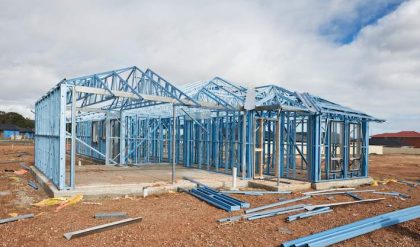Site Investigation
Site investigations should always be done before any design work, in order to obtain geotechnical information, parameters, and data about the site. Site investigation reports usually include location of the proposed structure, size of the proposed structure, site surveys, possible loads, topography, history of the site, overall stability of site, material composition and data of site (ex. Standard penetration test counts), soil and ground conditions of the site, surface drainage conditions, and moisture content. Site investigation reports should also include an appraisal section of whether there are any adjacent existing foundations, due to their effects on the proposed structure.
For shallow foundations, tests that should be done include determining maximum shear capacity for bearing capacity and determining settlements and moisture content. The structure should be investigated to a depth of 1.5 times the width of the footing area or building for shallow foundations.
For deep foundations, tests that should be done include using boreholes to determine piles’ suitability and determining bearing capacity and settlements. For deep foundations, investigation should continue down 3m beyond top of bedrock in order to determine whether the thickness of the rock layer is sufficient.
The following information should be determined for the corresponding structural activities.
| Soil | Clay | |
| Excavation | – Permeability- Stability of excavation- Shear strength of retaining structures | – Stability of excavation- Shear strength of retaining structures- Strength of clay and possibility of reusing material as fill |
| Shallow footings | – Shear strength of footing for bearing capacity- Loading tests for settlements | – Shear strength of footing for bearing capacity- Consolidation for settlements- Moisture content and plasticity tests |
| Deep foundations | – Test piles for bearing capacity and settlements- Boreholes | – Long-term test pile for bearing capacity and settlement- Boreholes- Shear strength of clay |
Contamination Investigation
Contamination of land can occur from chemical, biological, or physical pollutants from land use and pollutants migrating from adjacent land uses by water or air. They can be combustible, toxic, metallic, or chemical. These pollutants (solid, gas, liquid) can cause harm to living organisms, waters, or property.
In order to alleviate contamination, disposal or treatment of contaminated soil should be done during excavation and replacing soil with clean fill or decreasing concentrated contaminated soil by blending it with clean soil. The method of remediation depends on the characteristic of the contaminant and the target. One can remove the contamination completely, decrease contamination concentrations or risk to below the required level, or remove the pathway (the path in which contaminants undertake to reach the site).
● Excavation
○ Contaminated soil can be excavated to a disposal or treatment plant. The site will then be replaced with clean fill material. This method is expensive but expenses can be cut by excavating only a certain amount of excavated material down to a cut off level and then filling the site back in with clean fill.
● Blending
○ Contaminated soil is mixed with clean material. This can decrease the contamination concentration, until it reaches an acceptable level. This method is more cost effective since a certain amount of soil needs only be replaced by clean material.
● Isolation
○ Isolation techniques include sheeting piling, barriers, slurry trenches and jet grouting.


Comments are closed.